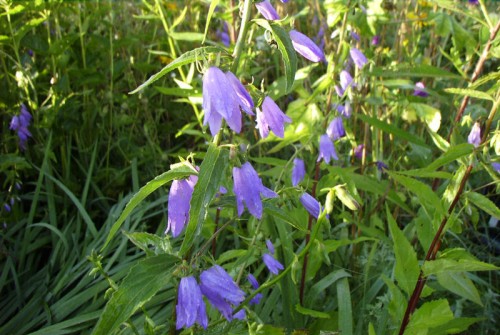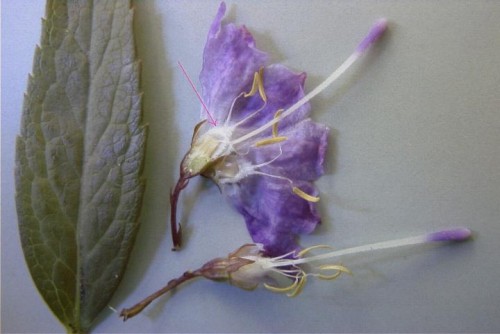So they say.
I outline my futile attempts to figure out the actual differences between these two plants in an essay on the last page of the current issue of Horticulture (which is actually the August/September issue). If you happen to arrive here because of that essay (despite the fact that there is no mention of, or link to, this website), welcome, and thank you for taking the trouble to find me. For everyone who has read the essay, here are a few additional tidbits:
- The “excellent image of Adenophora lilifolia” that I refer to in the essay is from the Utrecht University Botanic Gardens FloraPix gallery. With permission, here is that same image with the glandular disk pointed out:
- Zoey’s post is here, along with a photo of the roots.
- No one seems to agree on the definition of invasive (as applied to plants), but after thinking it over, I don’t think invasive is the best term for this plant. Because the roots can be so fine and go so deep, it is one of those plants that, once you have it, you will never be rid of it. And given deeply dug and wonderfully rich soil, it will take all that and run with it. Aggressive, yes. A thug, yes. But I think invasive should be reserved for those plants that are not merely bullies in the garden, but jump the fence and begin taking over the world, creating monocultures. I note that every politically correct plant organization takes pains to define invasive plants as non-native, because, heh, given the right conditions, native plants can jump the fence and create monocultures, too. (Ever see of field of goldenrod? And leave it undisturbed in your flower bed and see if there’s anything else left in that bed at the end of three years. Been there. Done that.)
Thank you to all of those who mentioned that they read the essay. I subscribe to Horticulture myself, and, ironically, that issue never came. Oh, my editor sent me the traditional author’s copy, but my subscription issue never came. I finally called and asked them to resend it.
Update
Anne Larson has further information on how to identify a true Adenophora.






This stuff is ruining landscapes all over our town! I call it invasive.
s
If I have an area I want planted with perennials, but don’t want to actively garden, I plant the thugs and let them battle it out…tansy, adenophora, beebalm, artemesia…
A friend of mine has labeled the adenophora “campanula horribilis” playing on Latin.
I do feel though that this campanula look-alike has given a bad rap to some great campanulas like Cherry Bells, Wedding Bells, Kent Belle, Sarasota, and Blue Clips; all worth planting in the right space.
eliz and firefly–I notice it’s a lot better behaved when planted with other thugs. It’s when you let it loose with more well-behaved plants that it demonstrates takeover tendencies.
Definitely pretty enough for a flower arrangement; that’s what suckered me in in the first place.
In my garden it’s a toss-up between Oxalis stricta, Campanula rapunculoides, and grass creeping in everywhere. It seems easier to pull the first two, and they keep the grass out and are good for bees.
If they get too aggressive and start drowning out things I’ve planted, then I start weeding.
Having them around is also keeping me from buying too many permanent things and overcrowding, I think. The garden looks full up.
Oh, yeah, this is out in the alley with the weeds. It stays there and I pick some now and then. A nice weed, but wouldn’t plant it on purpose.
Zoey, I remember how relieved I was the day I first read your post and realized I wasn’t the only one who found it to be a problem. Thank you for permitting me to quote you. You might never be rid of it, but at least it’s not as ugly as Canada thistle.
Kathy,
I read your article. Thanks for posting the picture to further clarify the glandular disk . I enjoyed the article very much.
I see creeing bellflower blooming in most of my gardens right now. I doubt if I will ever be rid of it.
I haven’t received this issue either, Kathy–it’s the last one in my subscription, which I’m going to let go–though it’s less expensive than on the newstand, I can get new issues much more quickly by buying them in town, rather than waiting weeks on end for issues. I’ll look forward to reading your essay. Oh, and I’m with you on creeping bellflower–it IS a pain, though not as bad as goutweed…
Creeping bellflower seems to be everywhere. It grows with great enthusiasm here … Some people actually encourage it in their gardens. That has always been a mystery to me …I am still trying to eradicate it from my front garden where it has crept through the stones. I wonder why I have never seen Adenophora in garden centres here. Since it appears to be a zone 3, I’m surprised.
Congratulations on your article! I will have to buy a copy of Horticultural to read it.
Carol, my issue finally came today. Since I already reported it as missing, I think a replacement copy is already on the way.
Kary, we have wild grapes but they don’t seem so out of control here. Birds love the fruit and will “plant” seeds wherever they perch, so it’s possible the vine is seed sown and not creeping over from your neighbor.
Tracy, great story!
My mom calls creeping bellflower “cancer of the garden.” I accidentally planted some (pass-along plants that hadn’t bloomed yet), and the moment she saw it she ripped it out! I was amazed, because it’s not like my mom to do something like that, but she said, “Do you really want cancer of the garden growing here?” Now that I recognize it, I see it everywhere.
Great article. Loved your thoughts on invasive vs. native. I too have been there done that but my error was to let a pretty teasel have a run for it only to spend the next three years digging it out of the lawn and every other flower bed. My current battle is with wild grapes that travelled from my neighbors fence line under the blacktop to my acre. I can’t seem to control where it goes at all. At first I thought it was kudzu but the local greenhouse said kudzu couldn’t handle our winters.
Again, congrats on the article, well done.
And how very odd that the one issue you would want more than any other, never arrived. I hope your subscription didn’t run out!